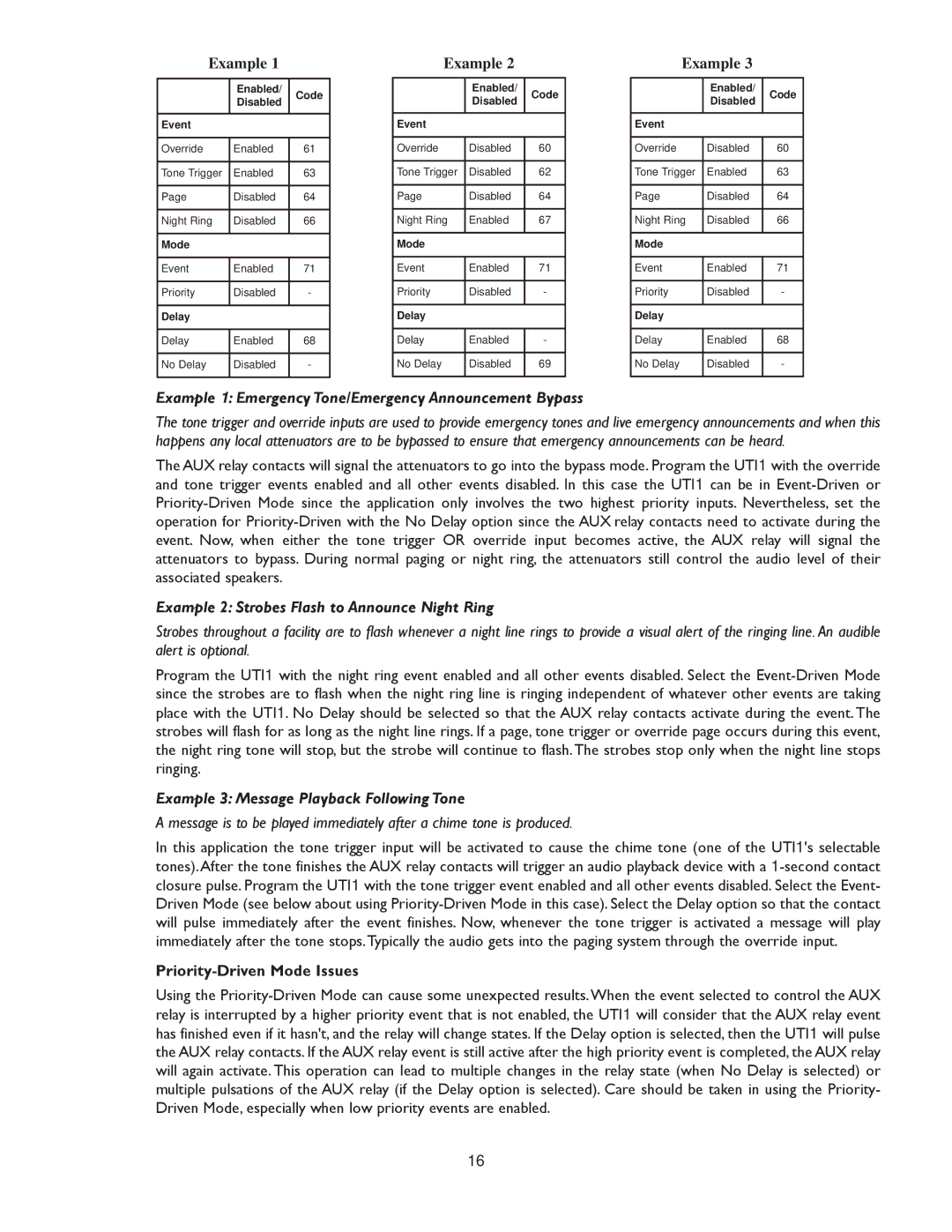Example 1 | | | Example 2 | | | Example 3 | |
| Enabled/ | Code | | | Enabled/ | Code | | | Enabled/ | Code |
| Disabled | | | Disabled | | | Disabled |
| | | | | | | |
| | | | | | | | | | |
Event | | | | Event | | | | Event | | |
| | | | | | | | | | |
Override | Enabled | 61 | | Override | Disabled | 60 | | Override | Disabled | 60 |
| | | | | | | | | | |
Tone Trigger | Enabled | 63 | | Tone Trigger | Disabled | 62 | | Tone Trigger | Enabled | 63 |
| | | | | | | | | | |
Page | Disabled | 64 | | Page | Disabled | 64 | | Page | Disabled | 64 |
| | | | | | | | | | |
Night Ring | Disabled | 66 | | Night Ring | Enabled | 67 | | Night Ring | Disabled | 66 |
| | | | | | | | | | |
Mode | | | | Mode | | | | Mode | | |
| | | | | | | | | | |
Event | Enabled | 71 | | Event | Enabled | 71 | | Event | Enabled | 71 |
| | | | | | | | | | |
Priority | Disabled | - | | Priority | Disabled | - | | Priority | Disabled | - |
| | | | | | | | | | |
Delay | | | | Delay | | | | Delay | | |
| | | | | | | | | | |
Delay | Enabled | 68 | | Delay | Enabled | - | | Delay | Enabled | 68 |
| | | | | | | | | | |
No Delay | Disabled | - | | No Delay | Disabled | 69 | | No Delay | Disabled | - |
| | | | | | | | | | |
Example 1: Emergency Tone/Emergency Announcement Bypass
The tone trigger and override inputs are used to provide emergency tones and live emergency announcements and when this happens any local attenuators are to be bypassed to ensure that emergency announcements can be heard.
The AUX relay contacts will signal the attenuators to go into the bypass mode. Program the UTI1 with the override and tone trigger events enabled and all other events disabled. In this case the UTI1 can be in Event-Driven or Priority-Driven Mode since the application only involves the two highest priority inputs. Nevertheless, set the operation for Priority-Driven with the No Delay option since the AUX relay contacts need to activate during the event. Now, when either the tone trigger OR override input becomes active, the AUX relay will signal the attenuators to bypass. During normal paging or night ring, the attenuators still control the audio level of their associated speakers.
Example 2: Strobes Flash to Announce Night Ring
Strobes throughout a facility are to flash whenever a night line rings to provide a visual alert of the ringing line. An audible alert is optional.
Program the UTI1 with the night ring event enabled and all other events disabled. Select the Event-Driven Mode since the strobes are to flash when the night ring line is ringing independent of whatever other events are taking place with the UTI1. No Delay should be selected so that the AUX relay contacts activate during the event. The strobes will flash for as long as the night line rings. If a page, tone trigger or override page occurs during this event, the night ring tone will stop, but the strobe will continue to flash.The strobes stop only when the night line stops ringing.
Example 3: Message Playback Following Tone
A message is to be played immediately after a chime tone is produced.
In this application the tone trigger input will be activated to cause the chime tone (one of the UTI1's selectable tones).After the tone finishes the AUX relay contacts will trigger an audio playback device with a 1-second contact closure pulse. Program the UTI1 with the tone trigger event enabled and all other events disabled. Select the Event- Driven Mode (see below about using Priority-Driven Mode in this case). Select the Delay option so that the contact will pulse immediately after the event finishes. Now, whenever the tone trigger is activated a message will play immediately after the tone stops.Typically the audio gets into the paging system through the override input.
Priority-Driven Mode Issues
Using the Priority-Driven Mode can cause some unexpected results.When the event selected to control the AUX relay is interrupted by a higher priority event that is not enabled, the UTI1 will consider that the AUX relay event has finished even if it hasn't, and the relay will change states. If the Delay option is selected, then the UTI1 will pulse the AUX relay contacts. If the AUX relay event is still active after the high priority event is completed, the AUX relay will again activate. This operation can lead to multiple changes in the relay state (when No Delay is selected) or multiple pulsations of the AUX relay (if the Delay option is selected). Care should be taken in using the Priority- Driven Mode, especially when low priority events are enabled.
